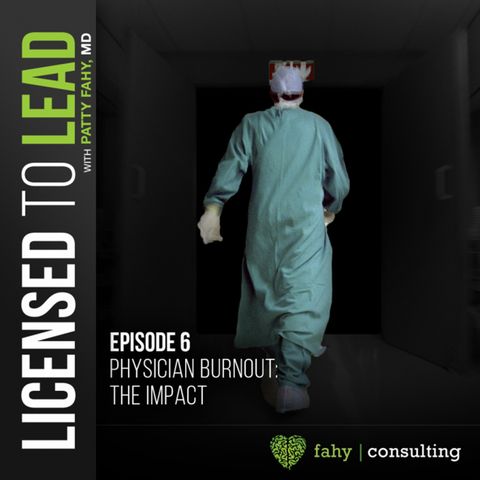006 - Physician Burnout: The Impact

Scarica e ascolta ovunque
Scarica i tuoi episodi preferiti e goditi l'ascolto, ovunque tu sia! Iscriviti o accedi ora per ascoltare offline.
Descrizione
This episode moves beyond the definition and underlying causes of burnout to focus on the impact on physicians, medical students, patients, and healthcare systems. Patty Fahy interviews a neurologist who...
mostra di più1. Physicians
When physicians are affected by burnout it leaves no stone unturned as far as the pervasive impact on career, colleagues, psyche, and relationships. The physician is even at increased risk of physical injury and illness. Patty talks through the data describing affected physicians including the rates of self-medication and depression. Little wonder that doctors in dysfunctional systems find ways to reduce exposure to the toxicity or escape it altogether.
2. Medical Students and Residents
Medical students arrive on campus healthier than their equivalent peer cohort. The first two years of medical school are infamous for the enormous load of work that is made heavier by evaluation, scrutiny, comparison, and incessant testing. The first two years culminates in months of preparation for the Step One exam. As classic “illegitimate work”—the Step One exam doesn’t correlate to future positive performance but does determine future residency options.
And what happens during that coveted residency? Between one-quarter and, one-third of residents have significant symptoms of depression according to a JAMA meta-analysis. Depending on the study and the measurement tools, up to three-quarters of residents have symptoms of burnout.
A significant part of burnout in residency is mediated by sleep deprivation. Those who benefit from having residents in the hospitals—state that the long shifts are in the interest of residents having the opportunity to provide continuity of care for patients. But it very much appears to be in the interest of residents providing continuity of exceedingly cheap labor for hospitals. Patty looks at the data purporting to justify long shifts despite the fact that residents’ cognition, memory, and judgment are impaired.
The issues related to medical students and residents are tragic and captured especially well in the film, Do No Harm: The Hippocratic Hoax [donoharmfilm.com].
3. Patients
When burnout affects doctors it also affects patients. When physicians, one way or another cut back, change careers, or retire—patients lose access to medical care. And when physician attitude and cognition are degraded by burnout their patients lose the attention and compassion of their personal physicians. Patients are even at risk of being harmed due to medical errors.
4. Health Systems
When leadership prioritizes profits over patients and willingly trades excellent medical care for more margin, it’s unlikely that physician burnout will get much attention. There’s no business case, right? Physicians get all their work done and take care of their unpaid gig as after-hours data entry clerks.
The financial costs of burnout are estimated to be $4.6 billion based on physician turnover and replacement analyses. Patty makes it clear that those “easily measured” costs are the tip of the iceberg. She dives into some of the high-cost factors of burnout that are a.) not easily measured and b.) inextricably bound up in human behavior. If you listened to Licensed to Lead Podcast #003 you will know those two elements are not likely to be compelling to leaders who have a business school mindset rather than an expert leadership mindset.
Reflections on a Decade Leading a Medical Student Well-Being Initiative by Stuart Slavin, MD
Sign up for our newsletter: https://bit.ly/LicensedToLeadSignup
Informazioni
| Autore | Patty Fahy, MD |
| Organizzazione | Patty Fahy, MD |
| Sito | - |
| Tag |
Copyright 2024 - Spreaker Inc. an iHeartMedia Company
